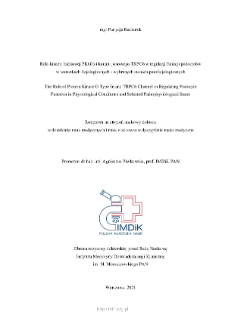
Object
Title: The Role of Protein Kinase G Type Iα and TRPC6 Channel in Regulating Podocyte Function in Physiological Conditions and Selected Pathophysiological States
Contributor:
Piwkowska, Agnieszka (Promotor)
Publisher:
Instytut Medycyny Doświadczalnej i Klinicznej im. M. Mossakowskiego PAN
Place of publishing:
Degree name:
Level of degree:
Degree discipline :
Degree grantor:
Mossakowski Medical Research Center PAS
Abstract:
Insulin-sensitive podocytes are a key part of glomerular filtration barrier. They controlthe glomerular filtrate pass across the filtration slit - a structure formed by interdigitating foot processes of podocytes. Loss of podocyte function leads to alternation of glomerular filtration barrier permeability. Increased glomerular barrier permeability results in albuminuria, the first clinical sign of diabetic kidney disease (DKD). Molecular mechanisms that regulate podocyte functioning and glomerular filtration barrier permeability in diabetes are still not fully understood.Calcium ions (Ca2+) are important mediators of cell homeostasis, and their influx is regulated by ion channels, including TRPC6. In podocytes, TRPC6 is involved in insulin-dependent regulation of the actin cytoskeleton dynamics, and thus in the regulation of glomerular filtration barrier permeability during physiological fluctuations in glomerular filtration.Protein kinase G type Ia (PKG Ia) is also involved in the regulation of glomerular filtration barrier permeability. Recent studies have confirmed a relationship between PKGIa activation, actin cytoskeleton reorganization and increased albumin permeability across the layer of podocytes that cover type IV collagen-coated nylon membrane.Dysregulation of the TRPC6 and PKGIa signaling pathways has negative impact on podocyte function. Therefore, it is important to identify signaling pathways that are activated by these proteins. The aim of this paper was to investigate the role of PKGIa and TRPC6 in the regulation of the signaling pathways crucial for podocyte functioning under both physiological and pathophysiological conditions. The present doctoral dissertation is based on a series of publications that have confirmed the relationship between the activities of TRPC6 and PKGIa, and insulin-dependent regulation of glomerular filtration barrier permeability. The conducted in vitro research has shown that insulin increases glomerular filtration barrier permeability via PKGIa/TRPC6 signaling pathway activation. Moreover, insulin induces actin reorganization as a result of the TRPC6-dependent Ca2+ influx into cultured podocytes.TRPC6 also plays a crucial role in the regulation of insulin-dependent glucose uptake in podocytes and affects the activity of AMP-activated protein kinase (AMPK), the main regulator of glucose metabolism. Furthermore, activation of both AMPK and TRPC6 is required for triggering Rac1 signaling pathway. The Rac1 signaling is associated with control of actin cytoskeleton dynamics and glucose uptake.Pathophysiological conditions like hyperinsulinemia or hyperglycemia disturb podocytefunctioning through the activation of the PKGIa/VASP signaling pathway. High concentrations of insulin or glucose increase both the amount of VASP and PKGIa-dependent phosphorylation of VASP at Ser239. Moreover, insulin and glucose induce actin cytoskeleton remodeling as well as augment albumin permeability across the podocyte layer in a VASP-dependent manner. These results clearly demonstrate the significance of the insulin-dependent signaling pathway and calcium signaling in the regulation of the functioning of podocytes and glomeruli, which may affect renal function. Disturbances in the insulin-dependent and TRPC6 signaling may significantly decrease the energy state of podocytes, thus impairing their function, and consequently, it may lead to alternations in glomerular filtration barrier permeability. The results obtained in the course of the present study also suggest that DKD development is induced by the activation of the PKGIa/VASP signaling pathway, which may result in increased glomerular filtration barrier permeability.
Detailed Resource Type:
Resource Identifier:
Source:
IMDiK PAN, sygn. ZS404 ; click here to follow the link
Language:
Language of abstract:
Rights:
Creative Commons Attribution BY 4.0 license
Terms of use:
Copyright-protected material. [CC BY 4.0] May be used within the scope specified in Creative Commons Attribution BY 4.0 license, full text available at: ; -
Digitizing institution:
Mossakowski Medical Research Institute PAS
Original in:
Library of the Mossakowski Medical Research Institute PAS
Projects co-financed by:
Access:
Object collections:
- Mossakowski Medical Research Institute PAS
- Mossakowski Medical Research Institute PAS > Theses > Ph.D Dissertationes
Last modified:
Apr 25, 2023
In our library since:
Jun 28, 2021
Number of object content downloads / hits:
97
All available object's versions:
https://rcin.org.pl/imdik/publication/229740

 INSTYTUT ARCHEOLOGII I ETNOLOGII POLSKIEJ AKADEMII NAUK
INSTYTUT ARCHEOLOGII I ETNOLOGII POLSKIEJ AKADEMII NAUK
 INSTYTUT BADAŃ LITERACKICH POLSKIEJ AKADEMII NAUK
INSTYTUT BADAŃ LITERACKICH POLSKIEJ AKADEMII NAUK
 INSTYTUT BADAWCZY LEŚNICTWA
INSTYTUT BADAWCZY LEŚNICTWA
 INSTYTUT BIOLOGII DOŚWIADCZALNEJ IM. MARCELEGO NENCKIEGO POLSKIEJ AKADEMII NAUK
INSTYTUT BIOLOGII DOŚWIADCZALNEJ IM. MARCELEGO NENCKIEGO POLSKIEJ AKADEMII NAUK
 INSTYTUT BIOLOGII SSAKÓW POLSKIEJ AKADEMII NAUK
INSTYTUT BIOLOGII SSAKÓW POLSKIEJ AKADEMII NAUK
 INSTYTUT CHEMII FIZYCZNEJ PAN
INSTYTUT CHEMII FIZYCZNEJ PAN
 INSTYTUT CHEMII ORGANICZNEJ PAN
INSTYTUT CHEMII ORGANICZNEJ PAN
 INSTYTUT FILOZOFII I SOCJOLOGII PAN
INSTYTUT FILOZOFII I SOCJOLOGII PAN
 INSTYTUT GEOGRAFII I PRZESTRZENNEGO ZAGOSPODAROWANIA PAN
INSTYTUT GEOGRAFII I PRZESTRZENNEGO ZAGOSPODAROWANIA PAN
 INSTYTUT HISTORII im. TADEUSZA MANTEUFFLA POLSKIEJ AKADEMII NAUK
INSTYTUT HISTORII im. TADEUSZA MANTEUFFLA POLSKIEJ AKADEMII NAUK
 INSTYTUT JĘZYKA POLSKIEGO POLSKIEJ AKADEMII NAUK
INSTYTUT JĘZYKA POLSKIEGO POLSKIEJ AKADEMII NAUK
 INSTYTUT MATEMATYCZNY PAN
INSTYTUT MATEMATYCZNY PAN
 INSTYTUT MEDYCYNY DOŚWIADCZALNEJ I KLINICZNEJ IM.MIROSŁAWA MOSSAKOWSKIEGO POLSKIEJ AKADEMII NAUK
INSTYTUT MEDYCYNY DOŚWIADCZALNEJ I KLINICZNEJ IM.MIROSŁAWA MOSSAKOWSKIEGO POLSKIEJ AKADEMII NAUK
 INSTYTUT PODSTAWOWYCH PROBLEMÓW TECHNIKI PAN
INSTYTUT PODSTAWOWYCH PROBLEMÓW TECHNIKI PAN
 INSTYTUT SLAWISTYKI PAN
INSTYTUT SLAWISTYKI PAN
 SIEĆ BADAWCZA ŁUKASIEWICZ - INSTYTUT TECHNOLOGII MATERIAŁÓW ELEKTRONICZNYCH
SIEĆ BADAWCZA ŁUKASIEWICZ - INSTYTUT TECHNOLOGII MATERIAŁÓW ELEKTRONICZNYCH
 MUZEUM I INSTYTUT ZOOLOGII POLSKIEJ AKADEMII NAUK
MUZEUM I INSTYTUT ZOOLOGII POLSKIEJ AKADEMII NAUK
 INSTYTUT BADAŃ SYSTEMOWYCH PAN
INSTYTUT BADAŃ SYSTEMOWYCH PAN
 INSTYTUT BOTANIKI IM. WŁADYSŁAWA SZAFERA POLSKIEJ AKADEMII NAUK
INSTYTUT BOTANIKI IM. WŁADYSŁAWA SZAFERA POLSKIEJ AKADEMII NAUK
































